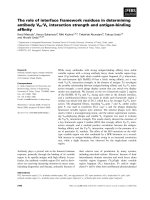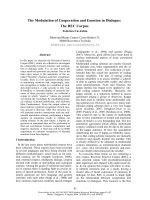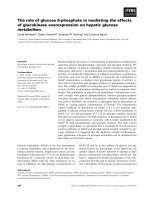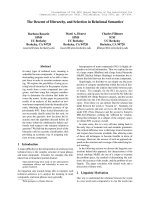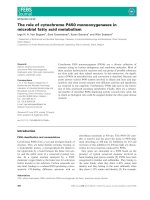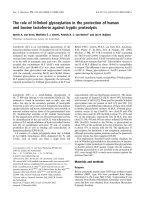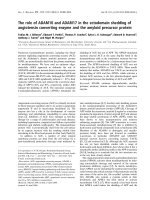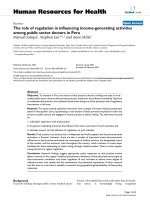Báo cáo sinh học: " The role of mutational analysis of KIT and PDGFRA in gastrointestinal stromal tumors in a clinical setting" doc
Bạn đang xem bản rút gọn của tài liệu. Xem và tải ngay bản đầy đủ của tài liệu tại đây (258.8 KB, 8 trang )
REVIEW Open Access
The role of mutational analysis of KIT and
PDGFRA in gastrointestinal stromal tumors in a
clinical setting
Alessandra Maleddu
1*
, Maria A Pantaleo
1,2
, Margherita Nannini
1
and Guido Biasco
1,2
Abstract
Gastrointestinal stromal tumors (GIST) are the most common mesenchymal tumors of the gastrointestinal tract.
Most GIST harbor a mutation affecting either the KIT or PDGFRA genes, whereas a small subgroup of tumors is
wild type for mutations.
Mutation of tyrosine kinase receptors is a mechanism of drug resistance that can occur either at the beginning of
treatment (primary resistance) or during the course of therapy (secondary resistance). In addition, mutational status
can predict the response to treatment with tyrosine kinase inhibitors, but the role of mutational status as a
prognostic factor remains controversial.
Evidence of a potential role of mutational status as a prognostic factor has emerged over the past decade. The
presence of KIT exon 11 insertion/deletion involving either one or both Trp557-Lys558 amino acids correlates with
a poorer clinical outcome if compared to patients with tumors wild type for KIT exon 11 mutations. A malignant
clinical behavior has also been documented for KIT exon 13 and KIT exon 9 mutant GIST. Patients with GIST
harboring a PDGFRA mutation seem to have a better prognosis than the others.
The aim of this paper is to review the clinical significance of tyrosine kinase mutational status.
Introduction
Gastrointestinal stromal tumors (GIST) are rare tumors
of the gastrointestinal t ract. They arise mostly in the
stomach, followed by the small bowel and c olon. Less
frequently they are found in the rectum, esophagus or
in an extra-gastrointestinal location. The biol ogy of
GIST has been widely investigated since Hirota et al. [1]
demonstrated mutations of the KIT receptor as a patho-
genic mechanism of GIST. Other mutations affecting
KIT exons 9, 13 and 17 have been demonstrated [2,3].
About 15% of GIST do not express KIT mutations and
of these approximately 5 to 7% have a mutation affect-
ing the gene encoding for PDGFRA [4]. There is also a
small subgroup of GIST, called wild type (WT), which
do not harbor either KIT or PDGFRA mutations [5].
KIT and PDGFRA are two trans-membrane receptors
that b elong to the type III tyrosine kinase family whose
natural ligands are stem cell factor (SCF) and platelet-
derived growth factor (PDGF). Both receptors have a
similar structure with five immunoglobulin-like domains
located on the extracellular side of the receptor, a trans-
membrane portion and an intracellular part containing
two tyrosine kinase domains: one with an adenosine tri-
phosphate (ATP) binding region and the other with a
phosphotransferase region (activation loop). Activation
of the receptor normally occurs with ligand binding
which triggers the receptor dimerization, the autopho-
sphorylation of the tyrosine kinase domain and finally
the activation of substrates like PI3K/Akt, Ras/MAPK
and JAK/STAT. This promote s cell cycle activation, cell
proliferation, and apoptosis inhibition [6,7]. Several
gain-of-function mut ations of KIT and PDGFRA affect-
ing different exons have been reported [8,9].
The correlation between KIT and PDGFRA muta-
tional stat us and the respon se to tyrosine kinase inhibi-
tors and their role in primaryandsecondaryresistance
has been widely investigated [10,11].
The aim of this paper is to review the clinical signifi-
cance of mutational status and its value as a predictive/
prognostic factor in limited and metastatic disease.
* Correspondence: alessandramaleddu@gm ail.com
1
“L.&A.Seragnoli” Department of Hematology and Oncological Sciences, S.
Orsola-Malpighi Hospital, University of Bologna, Italy
Full list of author information is available at the end of the article
Maleddu et al. Journal of Translational Medicine 2011, 9:75
/>© 2011 Maleddu et al; licensee BioMed Central Ltd. This is an Open Acce ss article distributed under the terms of the Creative
Commons Attribution License ( ), which permits unrestricte d use, distribution, and
reproduction in any medium, provided the original work is properly cited.
Prognostic value of mutational analysis in
localized GIST
Whenever possible surgery is the best treatment for
GIST. Unfortunatel y, even after radical surgery the five-
year survival rate is about 54% and the disease-free sur-
vival (DFS) is 45% [12,13]. Tumor size (≥10 cm), mitotic
rate (≥5/50HPF) and tumor location are known to be
independent prognostic factors for shorter DFS in fully
resected GIST patients. In 2002 Fletcher et al. developed
a risk stratification for primar y tumors (National Health
Institute -NHI classification), considering tumor size
and mitotic count as predictive factors of aggressive
behavior [6]. In 2006 Miettinen and L asota analyzed the
follow-updatafrommorethan 1600 fully resected
tumors and, on the basis of their results, revised the
NIH classification adding primary tumor location as an
important prognostic factor to identify the class of risk
for resected primary GIST [7]. According to the latest
classification, the risk of recurrence goes from being
very low for small tumors (≤ 2 cm) with low mitotic
rate (≤5/50HPF) and gastric location, to close to 90% for
large tumors (> 10 cm) with high mitotic rate (≥ 5/
50HPF) and small intestinal location [7]. Due to a wide
spectrum of behavior, it is crucial to find further factors
that can have a prognostic value in predicting the risk
of relapse for fully resected tumors. The importance o f
the mutational status of KIT and PDGFRA as a prog-
nostic factor remains controversial, although its predic-
tive value on tyrosine kinase inhibitors response is now
clearer.
Early evidence of a potential role of mutational status
as a prognostic factor appeared in the late nineties,
when different groups observed a correlation between
KIT exon 11 mutations and a poor er clinical outcome
compared to patients with tumors WT for KIT exon 11
mutations. Ernst et al. identified a subgroup of 13 KIT
exon 11 mutant tumors in a larger group of 35 GIST
patients and observed that the mutation was associated
with a shorter survival rate (p = 0.001). No correlation
between mutations, tumor size or mitotic index was
observed [14]. When GIST were still classi fied as malig-
nant or benign, KIT exon 11 mutations were notice d to
be more common in the malignant subtype [15]. In
addition, a study of 124 GIST patients showed a clear
difference in prognosis for patients with or without KIT
exon 11 mutations and a subdivision into mutation-
positive and mutation-negative patients was proposed
[16]. However, in 1999 only KIT exon 11 was studied
and the prognostic role of mutations could not be
evaluated.
Malignant clinical behavior was also documented for
KIT exon 9 and K IT exon 13 mutant GIST [16-18], and
for the first time the association between KIT exon 9
mutation and small intestinal location was reported [17].
In general, all the cited studies focused on KIT exon 11
mutations, whereas few dealt with KIT exon 9, 13 or 17
mutations . Th e first study to scre en KI T exons 9, 11, 13,
and 17 for mutations was performed in 2002 by Singer et
al.: 44 tumors out of 48 harbored a KIT mutation. They
found a KIT mutation was associated with a poor clinical
outcome and they also hypothesized that specific KIT
mutations could have a prognostic value. The multivari-
ate analysis showed that patients with GIST harboring a
KIT deletion/insertion had a significantly shorter recur-
rence-free survival (RFS) than patients with tumors har-
boring a KIT exon 11 missense mutation, which was
more common in favorable-outcome, low-grade GIST
[19]. A larger study on 120 patients identified two small
subgroups with differ ent clinical outcomes [20]. The first
small subgroup of eight cases had a more favorable prog-
nosis and consisted of tumors harboring an insertion of
6-20 amino acids re presenting intra-tandem-dupl ications
(ITDs) at the 3’ end of exon 11. All eight tumors were
located in the stomach, had a spindle cell morphology,
and a low mitotic count. Patients were all older than 60
years of age and seven out of eight were female. The sec-
ondsubgroupincluded13tumorsthatharboredaKIT
exon 9 mutation, had a predominan t small intestinal
location and a poorer outcome compared to the other
patients [18].
In 2005 a large retrospective study by Kim et al.
enrolled 86 patients who underwent radic al resection of
localized GIST [21]. Sixty-one GIST had a mutation of
KITexon11andthreehadamutationofKITexon9.
KIT exons 13 and 17 were screened but no mutations
were found in 2 2 tumors. The class of risk considering
tumor size and the mitotic rate was identified for all the
patients. All three KIT exon 9 mutations were insertions
of six nucleotides, resulting in duplication of Ala502-
Tyr503, two patients had a high risk GIST but all three
KIT exon 9 mutants had a relapse of the disease. The
most common mutation of KIT exon 11 was a deletion
that invo lved codons between 550 and 570. Three IDTs
were also found in tumors with spindle cell morphology,
no mitotic act ivity and benig n clinical behaviors. The
patients were all female and were all alive and relapse-
free after 24-80 months of follow-up, despite the tumor
risk class. In general the five-year RFS for patients
whose tumor harbored a KIT mutation was significantly
shorter than for patients with tumors without KIT
mutations. KIT mutations were also observed to be
associated with a higher mitotic rate, which together
with tumor size was already a known negative prognos-
tic factor [21].
Wardelmann et al. correlated the mutational status of
55 GIST and the clinical outcome. The size of 50
tumors was known, 21 tumors had a diameter ≤ 5cm
and none of them had evidence of metastasis, 29 tumors
Maleddu et al. Journal of Translational Medicine 2011, 9:75
/>Page 2 of 8
had a diameter larger than 5 cm and 15 of them had a
metastatic spread. A mutation affecting 557 and/or 558
codons of KIT exon 11 was found in 13 of 15 metastatic
tumors and in only two of the nine mutated and not
metastatic tumors. T hese results suggested that muta-
tions involving 557 and/or 558 codons could be used as
an additional parameter to estimate poor survival [22].
Subsequent studies confirmed the hypothesis of an asso-
ciation between a KIT exon 11 insertion/deletion invol-
ving either one or both Trp557-Lys558 amino acids and
a poor clinical outco me [23,24]. DeMatteo et al. studied
a series of 127 non-metastatic GIST patients who
underwent complete tumor resection and were all
enteredinafollow-upprogram[24].Asexpected,
tumor size, mitotic rate and location predicted the RFS
in the multivariate analysis. Only in the univariate analy-
sis did KIT exon 9 mutations and KIT exon 11 deletions
involving codons 557 and/or 558 correlate with a hig her
rate of recurrence, whereas patients with poi nt of muta-
tion or insertion of KIT exon 11 had a lower rate of
recurr ence, and patients with WT tumors had an inter-
mediate outcome. Only four patients had a GIST har-
boring a mutation of KIT exon 9, they all had a disease
recurrence but the number was too small to hypothesize
a prognostic value [24].
The Spanish Group for Sarcoma Research (GEIS)
selected 162 patients who underwent complete resection
of localized GIST between 1994 and 2001. All the
tumors were ≥ 2cmandKITpositiveatimmunohisto-
chemical analysis. They evaluated the prognostic value
of RFS prediction of different KIT and PDGFRA muta-
tions. The results were analyzed when the median fol-
low-upwas42monthsandatthatpoint41ofthe162
patients experienced a d isease recurrence and the five-
year RFS was 68%. According to the NIH and the Miet-
tinen-Lasota risk classifications, tumors with a high
mitotic count and large dimensions had a significantly
shorter RFS. In addition, followin g the Miettinen-Lasota
revised risk classification the RFS was significantly
shorter for patients whose primary tumor was located in
the small bowel compared to patients whose primary
tumor was loca ted in t he stomach. A very interesting
statistic was the higher recurrence rate (5-year RFS 57%
± 13%) of tumors harboring mutati ons of the KIT gene,
rather than tumors without KIT mutations (5-year RFS
80% ± 11%). In the univaria te analysis, patients with
deletions involving codons 557 and/or 558 of K IT exon
11 had a less favorable outcome than patients with dif-
ferent mutations or without KIT mutations. The pre-
sence of deletions involving codons 557 and/or 558 of
KIT exon 11 was also significantly associated with a
higher rate of recurrence in the multivariate analysis
together with size, mitotic count and high cellularity,
which are known prognostic factors [25].
After a longer follow-up, the data from the same group
of 162 patients were analyzed again by the Spanish
Group for Sarcoma Research (GEIS). The first analysis
demonstrated that the mutations within KIT exon 11
involving codons 557 and/or 558 have a prognostic rele-
vance. The objective of the new study was to demonstrate
if critical deletions still are an independent prognostic
factor after a longer follow-up, and if t here were any
time-related prognostic factors for RFS. When the an aly-
sis was performed the median follow-up was 84 months,
the factors assessed were the class of risk (both classifica-
tions NIH and Miettinen-Lasota were considered) and
the type of mutation. Mutations were also classified as
deletions of codons 557 and/or 558 of KIT exon 11 (criti-
cal mutations), non-deletion-type mutations of KIT exon
11 (NDTM) which included missense mutations and
insertions, and other deletions of KIT exon 11. Results
showed that, for the first four years after surgery and for
the entire seven-year follow-up the presence of critical
deletions belonging to a high-risk category were indepen-
dent prognostic factors for RFS. In the first 4 years after
surgeryonlythehigh-riskcategory of the Miettinen-
Lasota classification and NDTM were independent prog-
nostic factors for RFS. In fact, the presence of critical
mutatio ns could be useful to identify a subset of patients
with a higher risk of relapse in the first four years after
surgery, whereas the presence of NDTM could identify a
subset of patients more likely to experience a relapse
beyond three or four years after surgery [26].
A better o utcome and a lower chance of metastasis
seem to be associated with PDGFRA exon 18 mutations
[27]. Lasota et al. screened 1000 GIST for KIT exon 11
mutations, KIT exon 9 (onlythenon-gastrictumors)
and PDGFRA exons 18 and 12. PDGFRA mutant
tumors had a prevalent gastric location, epithelioid mor-
phology (pure or prevalent) and low mitotic count. Of
1000 GIST, a PDGFRA exon 18 mutation was found in
122 of the 346 gastric tumors and only two of t he 75
small intestinal tumors. Ten of the 170 gastric tumors
and one of the 54 small intestinal tumors had a
PDGFRA exon 12 mutation. One hundred and five of
those had ≤5 mitosis/50HPF, and 40 had no mitotic
activity. Clinical data were available for 91 out of 128
PDGFRA exon 18 mutant tumors. After a median fol-
low-up of 135 months, 41 were alive and with no evi-
denc e of disease, 24 had died from other causes, 16 had
died for unknown causes, and ten had a progressive dis-
ease. Seven died of the disease and three were stil l alive
at the end of the follow-up (370 months). The authors
concluded that 83% of GIST with PDGFRA mutations
haveagoodprognosis[27].Thesamegroupofscien-
tists d emonstrated later that PDGFRA exon 14 mutant
GISTaremostlygastric,haveepithelioidmorphology
and benign clinical behavior [28].
Maleddu et al. Journal of Translational Medicine 2011, 9:75
/>Page 3 of 8
Predictive value of response to therapy
Although the role of KI T/PDGFRA mutational status as
a prognostic factor is controversial, it is well known to
predict the response to treatment with tyrosine kinase
inhibitors.
The mutation of tyrosine kinase receptors is a
mechanism of d rug resistance occurring either at the
beginning of treatment (primary resistance) or during
the course of therapy (secondary resistance).
The first study that showed the correlation between
the response to imatinib at a dose of 400 mg/day and
mutational status in GIST was performed by Heinrich et
al. One hundred and twenty-seven patients with meta-
static GIST received imatinib, 71 had a tumor with a
mutation of KIT exon 11, 23 of KIT exon 9, two of KIT
exon 13 and KIT exon 17; PDGFRA exon 18 was
mutated in six cases and nine tumors were WT. The
clinical response varied considering the different muta-
tions, the stronger predictor of response being any KIT
exon 11 mutation. The 87.5% of patients whose tumor
had a KIT exon 11 mutation achieved a partial response,
whereas only 47.8% of patients whose tumor had a KIT
exon 9 mutation had a partial response [10].
The European Organization for Research and Treat-
ment of Cancer (EORTC) phase I and II studies [29-31]
enrolled patients with metastatic GIST and tested the
safety of imatinib given at a dose of 400 mg/day or 800
mg/day and investigated its activity. The results of the
mutational analysis performed on 37 tumor specimens
showed a further correlation between certain mutations
and their response to imatinib. Of the 37 tumors, 24
had a KIT exon 11 mutation, four had a KIT exon 9
mutation, one had a KIT exon 13 mutation and two had
a PDGFRA exon 18 mutation. Patients whose tumors
had a KIT exon 11 mutation had a higher partial
response rate than the others and patients whose
tumors harbored a KIT mutation enjoyed a longer med-
ian survival time and a lower recurrence rate [32].
Two recent randomized phase III studies compared
the outcome of met astatic GIST patients treated with
imatinib 400 mg/day or 800 mg/day. The EU-AUS trial
(EORTC and Australian Gastro-Intestinal Trial Group)
enrolled 946 patients with metastatic GIST between
2001 and 2002. The primary endpoint of t he study was
RFS and the patients were randomized to receive imati-
nib at the two doses with the possibility of cross over to
the higher doses in case of progressive disease [33].
Mutational analysis was performed in 377 cases: 248
harbored a KIT exon 11 mutation, 58 a KIT exon 9
mutation, six a KIT exon 13 mutation, and three a KIT
exon 17 mutation, whereas ten tumors harbored a
PDGFRA exon 18 mutation. P atients with tumors
expressing any mutation of KIT exon 11 had a higher
response rate and a longer median survival than patients
whose tumors harbored KIT exon 9 mutations or whose
tumors were WT. Once the KIT exon 11 tumor mutant
group was divided into subgroups, the statistical analysis
revealed a poorer outcome for patients whose tumor
had large exon 11 deletions, especially if involving
codons 577-579, this may be due to the conformational
change in the receptor. In the group of KIT exon 9
mutant tumors the response rate was significantly
higher for patients enrolled in the 800 mg/day arm [33].
The other phase III study (US-CDN) was conducted
by the Southwest Oncology Group (SWOG), Cancer
and Leukemia Group B (CALGB), National Cancer
Institute of Canada (NCI-C) and Eastern Cooperative
Oncology Group (ECOG) [34]. This study, which had
OS as primary endpoint, enrolled 746 patients with
advanced GIST and randomized them to receive imati-
nib 400 mg/day or 800 mg/day e qual to the EU-AUS
trial. Of the total, 428 tumors were screened for KIT
and PDGFRA mutations. The analysis disclosed a KIT
exon 11 mutation in 283 cases, a KIT exon 9 mutation
in 32 cases, whereas 67 tumors were WT. Patients were
randomly assigned to receive imatinib at the daily dose
of 400 mg or 800 mg. The time to progression (TTP)
did not change for patients with any KIT exon 11 muta-
tion or WT GIST. Patients with a KIT exon 9 mutation
had a significantly higher rate of response if treated with
imatinib at the daily dose of 800 mg, but there was no
difference in time to progression and overall survival
between the two groups. No differences were observed
for KIT exon 11 mutant or WT GIST treated with 400
or 800 mg/day. Instead, any KIT exon 11 mutation was
associated with a better outcome in patients with
advanced GIST treated with imatinib compared to
patients with KIT exon 9 mutations or WT tumors [34].
The Gastrointestinal S tromal Tumor Meta-Analysis
Group (MetaGIST) re-analyzed and compared the data
from the EU-AUS a nd the US-CDN studies to confirm
the results, validate the suggested prognostic and predic-
tive factors and to explain the differences between
results in the two studies by reviewing the characteris-
tics of the two populations.
A small advantage on PFS was observed for the high-
dose arm in both studies, no difference in overall survi-
val (OS). Prognostic factors for PFS and OS were then
considered. Mutational status was a significant prognos-
tic factor (p < 0.0001) for PFS, and patients with KIT
exon 11 mutation had a more favorable prognosis than
those with exon 9 mutation or WT.
Exon 9 mutation was the o nly significant predictive
factor for a benefit of high-dose therapy. Patients with
KIT exon 9 mutations treated with imatinib 800 mg/day
had a significantly longer PF S than the others and the
Maleddu et al. Journal of Translational Medicine 2011, 9:75
/>Page 4 of 8
estimated rate of progression or death was also signifi-
cantly decreased (p = 0.017) [35].
A further phase III trial compared two doses of imati-
nib for treatment of unresectable advanced GIST. To
investigate the influence of m utational status on imati-
nib response, 128 GIST specimens from those patients
were screened for KIT and PDGFRA mutations. The
estimated median surviva l was 63 months for patients
whose tumor harbored a KIT exon 11 mutation, 44
months for patients whose tumors harbored a KIT exon
9 mutation and 26 months in case of other mutations
or WT GIST. In addition, a mutation within KIT exon
11 was associated with a better outcome for the first 30
months of therapy [36].
Fewer stud ies have defined the role of mutational sta-
tus as a prognostic and predi ctive factor in the adjuvant
setting. It is well known that adjuvant therapy with ima-
tinib is associated with a longer RFS [37]. For this p ur-
pose 713 patients who under went complete resection of
a primary GIST were enrolled on the Z9001 study. All
primary tumors were ≥3 cm and expressed KIT. Patients
were randomized to receive imatinib 400 mg/day for
one year or a placebo. Tu mor size, mitotic index and
mutational status were available for 513 patients. After a
median follow-up of 20 months, the two-year RFS was
74% in the placebo arm vs. 91% in the imatinib arm.
The two-year RFS for patients with KIT exon 11 muta-
tion was 65% vs. 91% (placebo and imatinib arm respec-
tively p < 0.0001), 76% vs. 100% for the PDGFRA
mutation (p < 0.01), whereas there were no difference in
overall RFS for KIT exon 9 mutation, but the one-year
RFS was shorter for patients in the placebo arm (80%)
than in the imatinib arm (100%). This study showed
that mutational status t ogether with pathological fea-
tures have a prognostic and predictive value for RFS
after complete surgical resection of primary GIST [38].
Secondary resistance occurs after a median period of
24 months of treatment with imatinib. There are several
mechanisms involved in resistance like the activation of
an alternative downstream signaling pathway such as
AKT/mTOR, the activation of a n alternate tyrosine
kinase receptor and the loss of KIT expression, the
genomic amplification of KIT, and the gain of new KIT/
PDGFRA mutations [39]. New KIT/PDGFRA mutations
are currently considered the most important and t he
most common mechanism [40-43].
Mutational analysis performed on tissue specimens
from resistant lesions disclosed secondary acquired
mutations developed during imatinib therapy. The fre-
quency of secondary mutations is over 50% in those
tumors with primary KIT exon 9 o r 11 mutations. Sec-
ondary mutations are single subs titutions and occur in
different exons but on the same allele of the primary
mutation. Similar to chronic myeloid leukemia, acquired
imatinib resistant mutations affect the tyrosine kinase
domain and the activation loop, encoded by exons 13,
14 and 17 re spectively [9,40,43-47]. The most common
secondary mutation is the V654A, mainly found in
GIST harboring an exon 11 primary mutatio n [48].
PDGFRA secondary mutations are rare. The D842V was
identified in one patient with primary mutatio n V561D,
which is known to be associated with imatinib resistance
[48]. In general, secondary mutations were detected only
in progressive nodules and notinnon-progressiveones
[46,49]. In addition, patients with WT GIST do not
develop secondary mutations [46]. A recent study by
Liegl et al. analyzed 53 metastases from 14 patients after
imatinib or sunitinib treatment failure. Primary tumors
included GIS T with classical features (KIT positive, and
mutated on KIT exons 9, 11, or 13), but also K IT nega-
tive tumors, GIST with unusual morphology, and KIT/
PDGFRA WT GIST. Secondary KIT mutations were
found in nine out of 11 GIST with KIT primary muta-
tion. Two to five different mutations were found in dif -
ferent metastases I six out of nine patients, and in three
out of nine patients two mutations were found in one
or more tumor samples. Five recurrent points of muta-
tion were located in the KIT tyrosine kinase domain
and in the ATP activation loop. No secondary mutations
were found in KIT/PDGFRA WT GIST or in those with
unusual morphology [47].
Sunitinib inhib its double mutant GIST and the
response to therapy is influenced by the mutational status
[11,50]. Seventy-eight imatinib resistant patients were
treated with sunitinib, 58% of patients had tumors har-
boring KIT exon 9 mutations, 34% had tumors harboring
KIT exon 11 mutations, and 56% of tumors were WT.
Results showed a significantly longer progression-free
survival and overall survival for patients with primary
KIT exon 9 mutations (p < 0.0005) or WT (p < 0.0356)
than for those with KIT exon 11 mutations. In addition,
patients whose tumor expressed a secondary mutation
affecting exons 13 or 14 had a better outcome than those
whose tumor had a KIT exon 17 or 18 mutation [11].
In addition to the cellular a nd mutational profile of
the disease, broad variations of imatinib plasma levels
have been monitored in GIST patien ts [51,52]. The
decrease of imatinib bioavailability during chronic thera-
pies should be considered a fu rther possible mechanism
of resistance. Recently Demetri et al. studied the imati-
nib pharmacokinetic a nd pharmacodynamic profiles in
advanced GIST patients to detect possible correlations
between the imatinib plasma concentrations and clinical
outcome. They observed that patients with the lowest
imatinib serum levels had the lowest overall response
rate and the shortest time to progression [51,52].
Maleddu et al. Journal of Translational Medicine 2011, 9:75
/>Page 5 of 8
Conclusions
The value of mutational status as a pr edictive and prog-
nostic factor for RFS in metastatic GIST treated with
imatinib is clear. What is now becoming more evident is
its potential role as a predictive and prognostic factor
for resected GIST treated with imatinib. Tumors har-
boring KIT exon 11 mutations have a better outcome
under imatinib treatment at a dose of 400 mg/day than
tumors harboring different mutations, and KIT exon 9
mutant tumors have a longer RFS if treated with the
high dose of imatinib, corresponding to 800 mg/day.
Patients with KIT exon 9 mutant tumors achieve a bet-
ter response to sunitinib, than those with exon 11 muta-
tions. The PDGFRA exon 18 D842V point mutant
activates PDGFRA both in vitro and in vivo [10,50] and
is also imatinib resistant in vivo and in vitro [30,53,54],
whereas other muta tions affecting exon 18 (D846Y,
N848K, Y849K and HDSN845-848 P) are imatinib sensi-
tive [53].
In the adjuvant setting, available data show that muta-
tional status can be considered a predictive and prog-
nostic factor for GIST patients treated with imatinib
after radical surgery [38].
Dei Tos et al. recently reviewed a series of 929
untreated GIST to correlate the natural history of dis-
ease with pathological features, but the mutational status
of tumors was not available [55]. Tumor size (≥10 cm),
mitotic rate (≥5/50HPF) and tumor location are the
only recognized independent prognostic f actors for
GIST patients [11,12], but unfortunately it is still
unclear whether or not mutational status could be an
independent prognostic factor for disease recurrence in
untreated patients. It would be useful to be able to
study mutational status on a large population of
untreated GIST but this has become more difficult since
evidence emerged of a longer RFS following adjuvant
treatment with imatinib.
Lastly, knowledge of the predictive and prognostic
value of mutati onal status could lead physicians to estab-
lish the dose of imatinib, identify those patients who
would not benefit from imatinib treatment (PDGFRA
exon 18 D842V mutant tumors are imatinib resistant),
chose a second line therapy, and evaluate the different
risk of relapse during follow-up. These data emphasize
that mutational status must play a predominant role in
the clinical management of patients and that new find-
ings are necessary to establish the mechanism s responsi-
ble for imatinib resistance in specific subsets of tumors
like PDGFRA D842V mutant and WT GIST.
Abbreviations
WT: Wild Type; ATP: Adenosine Triphosphate; PDGFRA: Platelet Derived
Growth Factor Receptor Alpha; TKI: Tyrosine Kinase Inhibitor; DFS: Disease
Free Survival; NHI: National Health Institute; HPF: High Power Field; ITDs:
Intra-Tandem-Duplications; RFS: Recurrence-Free Survival; NDTM: Non-
Deletion-Type-Mutations; OS: Overall Survival; PFS: Progression-Free Survival.
Author details
1
“L.&A.Seragnoli” Department of Hematology and Oncological Sciences, S.
Orsola-Malpighi Hospital, University of Bologna, Italy.
2
“G. Prodi”
Interdepartmental Centre of Cancer Research, University of Bologna, Italy.
Authors’ contributions
AM designed the study, carried out the acquisition and participated in data
interpretation. GB participated in data interpretation and manuscript revision.
MN participated in the acquisition and interpretation of the data. MAP
conceived the study, helped to draft the manuscript and interpret the data.
All authors read and approved the final manuscript.
Competing interests
The authors declare that they have no competing interests.
Received: 14 December 2010 Accepted: 23 May 2011
Published: 23 May 2011
References
1. Hirota S, Isozaki K, Moriyama Y, Hashimoto K, Nishida T, Ishiguro S,
Kawano K, Hanada M, Kurata A, Takeda M, Muhammad Tunio G,
Matsuzawa Y, Kanakura Y, Shinomura Y, Kitamura Y: Gain of function
mutations of c-kit in human gastrointestinal stromal tumors. Science
1998, 279:577-580.
2. Lux ML, Rubin BP, Biase TL, Chen CJ, Maclure T, Demetri G, Xiao S, Singer S,
Fletcher CD, Fletcher JA: KIT extracellular and kinase domain mutations in
gastrointestinal stromal tumors. Am J Pathol 2000, 156:791-795.
3. Rubin BP, Singer S, Tsao C, Duensing A, Lux ML, Ruiz R, Hibbard MK,
Chen CJ, Xiao S, Tuveson DA, Demetri GD, Fletcher CD, Fletcher JA: KIT
activation is a ubiquitous feature of gastrointestinal stromal tumors.
Cancer Research 2001, 61:8118-8121.
4. Heinrich MC, Corless CL, Duensing A, McGreevey L, Chen CJ, Joseph N,
Singer S, Griffith DJ, Haley A, Town A, Demetri GD, Fletcher CD, Fletcher JA:
PDGFRA activating mutations in gastrointestinal stromal tumors. Science
2003, 299:708-710.
5. Medeiros F, Corless CL, Duensing A, Hornick JL, Oliveira AM, Heinrich MC,
Fletcher JA, Fletcher CD: KIT-negative gastrointestinal stromal tumors. Am
J Surg Pathol 2004, 28:889-894.
6. Fletcher CD, Berman JJ, Corless C, Gorstein F, Lasota J, Longley BJ,
Miettinen M, O’Leary TJ, Remotti H, Rubin BP, Shmookler B, Sobin LH,
Weiss SW: Diagnosis of gastrointestinal stromal tumors: A consensus
approach. Hum Pathol 2002, 33:459-465.
7. Miettinen M, Lasota J: Gastrointestinal stromal tumors: review on
morphology, molecular pathology, prognosis, and differential diagnosis.
Arch Pathol Lab Med 2006, 130:1466-1478.
8. Lasota J, Miettinen M: Clinical significance of oncogenic KIT and PDGFRA
mutations in gastrointestinal stromal tumours. Histopathology 2008,
53:245-266.
9. Corless CL, Fletcher JA, Heinrich MC: Biology of Gastrointestinal Stromal
Tumors. J Clin Oncol 2004, 22:3813-3825.
10. Heinrich MC, Corless CL, Demetri GD, Blanke CD, von Mehren M,
Joensuu H, McGreevey LS, Chen CJ, Van den Abbeele AD, Druker BJ,
Kiese B, Eisenberg B, Roberts PJ, Singer S, Fletcher CD, Silberman S,
Dimitrijevic S, Fletcher JA: Kinase mutations and imatinib response in
patients with metastatic gastrointestinal stromal tumors. J Clin Oncol
2003, 21:4342-4349.
11. Heinrich MC, Maki RG, Corless CL, Antonescu CR, Harlow A, Griffith D,
Town A, McKinley A, Ou WB, Fletcher JA, Fletcher CD, Huang X, Cohen DP,
Baum CM, Demetri GD: Primary and Secondary Kinase Genotypes
Correlate With the Biological and Clinical Activity of Sunitinib in
Imatinib-Resistant Gastrointestinal Stromal Tumor. J Clin Oncol 2008,
33:5352-5359.
12. Gold JS, Gönen M, Gutiérrez A, Broto JM, García-del-Muro X, Smyrk TC,
Maki RG, Singer S, Brennan MF, Antonescu CR, Donohue JH, DeMatteo RP:
Development and validation of a prognostic nomogram for recurrence-
free survival after complete surgical resection of localised primary
gastrointestinal stromal tumour: a retrospective analysis. Lancet Oncol
2009, 10:1045-1052.
Maleddu et al. Journal of Translational Medicine 2011, 9:75
/>Page 6 of 8
13. DeMatteo RP, Lewis JJ, Leung D, Mudan SS, Woodruff JM, Brennan MF: Two
hundred gastrointestinal stromal tumors: recurrence patterns and
prognostic factors for survival. Ann Surg 2000, 231:51-58.
14. Ernst SI, Hubbs AE, Przygodzki RM, Emory TS, Sobin LH, O’Leary TJ: KIT
mutation portends poor prognosis in gastrointestinal stromal/smooth
muscle tumors. Lab Invest 1998, 78:1633-1636.
15. Lasota J, Jasinski M, Sarlomo-Rikala M, Miettinen M: Mutations in exon 11
of c-Kit occur preferentially in malignant versus benign gastrointestinal
stromal tumors and do not occur in leiomyomas or leiomyosarcomas.
Am J Pathol 1999, 154:53-60.
16. Taniguchi M, Nishida T, Hirota S, Isozaki K, Ito T, Nomura T, Matsuda H,
Kitamura Y: Effect of c-kit mutation on prognosis of gastrointestinal
stromal tumors. Cancer Res 1999, 59:4297-4300.
17. Lasota J, Wozniak A, Sarlomo-Rikala M, Rys J, Kordek R, Nassar A, Sobin LH,
Miettinen M: Mutations in exons 9 and 13 of KIT gene are rare events in
gastrointestinal stromal tumors. A study of 200 cases. Am J Pathol 2000,
157:1091-1095.
18. Sakurai S, Oguni S, Hironaka M, Fukayama M, Morinaga S, Saito K:
Mutations in c-kit gene exons 9 and 13 in gastrointestinal stromal
tumors among Japanese. Jpn J Cancer Res 2001, 92:494-498.
19. Singer S, Rubin BP, Lux ML, Chen CJ, Demetri GD, Fletcher CD, Fletcher JA:
Prognostic value of KIT mutation type, mitotic activity, and histologic
subtype in gastrointestinal stromal tumors. J Clin Oncol 2002,
20:3898-3905.
20. Antonescu CR, Sommer G, Sarran L, Tschernyavsky SJ, Riedel E,
Woodruff JM, Robson M, Maki R, Brennan MF, Ladanyi M, DeMatteo RP,
Besmer P: Association of KIT exon 9 mutations with nongastric primary
site and aggressive behavior: KIT mutation analysis and clinical
correlates of 120 gastrointestinal stromal tumors. Clin Cancer Res 2003,
9:3329-3337.
21. Kim TW, Lee H, Kang YK, Choe MS, Ryu MH, Chang HM, Kim JS, Yook JH,
Kim BS, Lee JS: Prognostic significance of c-kit mutation in localized
gastrointestinal stromal tumors. Clin Cancer Res 2004, 10:3076-3081.
22. Wardelmann E, Losen I, Hans V, Neidt I, Speidel N, Bierhoff E, Heinicke T,
Pietsch T, Büttner R, Merkelbach-Bruse S: Deletion of Trp-557 and Lys-558
in the juxtamembrane domain of the c-kit protooncogene is associated
with metastatic behavior of gastrointestinal stromal tumors. Int J Cancer
2003, 106:887-895.
23. Andersson J, Bümming P, Meis-Kindblom JM, Sihto H, Nupponen N,
Joensuu H, Odén A, Gustavsson B, Kindblom LG, Nilsson B: Gastrointestinal
stromal tumors with KIT exon 11 deletions are associated with poor
prognosis. Gastroenterology 2006, 130:1573-1581.
24. Dematteo RP, Gold JS, Saran L, Gönen M, Liau KH, Maki RG, Singer S,
Besmer P, Brennan MF, Antonescu CR: Tumor mitotic rate, size, and
location independently predict recurrence after resection of primary
gastrointestinal stromal tumor (GIST). Cancer 2008, 112:608-615.
25. Martín J, Poveda A, Llombart-Bosch A, Ramos R, López-Guerrero JA, García
del Muro J, Maurel J, Calabuig S, Gutierrez A, González de Sande JL,
Martínez J, De Juan A, Laínez N, Losa F, Alija V, Escudero P, Casado A,
García P, Blanco R, Buesa JM, Spanish Group for Sarcoma Research:
Deletions affecting codons 557-558 of the c-KIT gene indicate a poor
prognosis in patients with completely resected gastrointestinal stromal
tumors: a study by the Spanish Group for Sarcoma Research (GEIS). J
Clin Oncol 2005, 23:6190-6198.
26. Martin-Broto J, Gutierrez A, Garcia-del-Muro X, Lopez-Guerrero JA, Martinez-
Trufero J, de Sande LM, Lainez N, Maurel J, De Juan A, Losa F, Andres R,
Casado
A, Tejido PG, Blanco R, Carles J, Bellmunt J, Gomez-Espana A,
Ramos R, Martinez-Serra J, Llombart-Bosch A, Poveda A: Prognostic time
dependence of deletions affecting codons 557 and/or 558 of KIT gene
for relapse-free survival (RFS) in localized GIST: a Spanish Group for
Sarcoma Research (GEIS) Study. Annals of Oncol 2010, 21:1552-1557.
27. Jerzy Lasota, Agnieszka Dansonka-Mieszkowska, Sobin Leslie H,
Markku Miettinen: A great majority of GISTs with PDGFRA mutations
represent gastric tumors of low or no malignant potential. Lab Invest
2004, 84:874-883.
28. Jerzy Lasota, Jerzy Stachura, Markku Miettinen: GISTs with PDGFRA exon
14 mutations represent subset of clinically favorable gastric tumors with
epithelioid morphology. Lab Invest 2006, 86:94-100.
29. van Oosterom AT, Judson I, Verweij J, Stroobants S, Donato di Paola E,
Dimitrijevic S, Martens M, Webb A, Sciot R, Van Glabbeke M, Silberman S,
Nielsen OS, European Organisation for Research and Treatment of Cancer
Soft Tissue and Bone Sarcoma Group: For the European Organisation for
Research and Treatment of Cancer Soft Tissue and Bone Sarcoma
Group: Safety and efficacy of imatinib (STI571) in metastatic
gastrointestinal stromal tumours - A phase I study. Lancet 2001,
358:1421-1423.
30. Demetri GD, von Mehren M, Blanke CD, Van den Abbeele AD, Eisenberg B,
Roberts PJ, Heinrich MC, Tuveson DA, Singer S, Janicek M, Fletcher JA,
Silverman SG, Silberman SL, Capdeville R, Kiese B, Peng B, Dimitrijevic S,
Druker BJ, Corless C, Fletcher CD, Joensuu H: Efficacy and safety of
imatinib mesylate in advanced gastrointestinal stromal tumors. N Engl J
Med 2002, 347:472-480.
31. Verweij J, van Oosterom A, Blay JY, Judson I, Rodenhuis S, van der Graaf W,
Radford J, Le Cesne A, Hogendoorn PC, di Paola ED, Brown M, Nielsen OS:
Imatinib mesylate (STI-571 Glivec, Gleevec) is an active agent for
gastrointestinal stromal tumours, but does not yield responses in other
soft-tissue sarcomas that are unselected for a molecular target: Results
from an EORTC Soft Tissue and Bone Sarcoma Group phase II study. Eur
J Cancer 2003, 39:2006-2011.
32. Debiec-Rychter M, Dumez H, Judson I, Wasag B, Verweij J, Brown M,
Dimitrijevic S, Sciot R, Stul M, Vranck H, Scurr M, Hagemeijer A, van
Glabbeke M, van Oosterom AT: Use of c-KIT/PDGFRA mutational analysis to
predict the clinical response to imatinib in patients with advanced
gastrointestinal stromal tumours entered on phase I and II studies of the
EORTC Soft Tissue and Bone Sarcoma Group. Eur J Cancer 2004, 40:689-695.
33. Debiec-Rychter M, Sciot R, Le Cesne A, Schlemmer M, Hohenberger P, van
Oosterom AT, Blay JY, Leyvraz S, Stul M, Casali PG, Zalcberg J, Verweij J, Van
Glabbeke M, Hagemeijer A, Judson I, EORTC Soft Tissue and Bone Sarcoma
Group; Italian Sarcoma Group; Australasian GastroIntestinal Trials Group: KIT
mutations and dose selection for imatinib in patients with advanced
gastrointestinal stromal tumors. Eur J Cancer 2006, 42:1093-1103.
34. Heinrich MC, Owzar K, Corless CL, Hollis D, Borden EC, Fletcher CD,
Ryan CW, von Mehren M, Blanke CD, Rankin C, Benjamin RS, Bramwell VH,
Demetri GD, Bertagnolli MM, Fletcher JA: Correlation of kinase genotype
and clinical outcome in the North American Intergroup Phase III Trial of
imatinib mesylate for treatment of advanced gastrointestinal stromal
tumor: CALGB 150105 Study by Cancer and Leukemia Group B and
Southwest Oncology Group. J Clin Oncol 2008, 26:5360-5367.
35. Van Glabbeke MM, Owzar K, Rankin C, Simes J, Crowley J, GIST Meta-
analysis Group (MetaGIST): Comparison of two doses of imatinib for the
treatment of unresectable or metastatic gastrointestinal stromal tumors
(GIST): A meta-analyis based on 1,640 patients (pts). Proceedings of The
American Society of Clinical Oncology abstr 2007, abstr 10004.
36. Blanke CD, Rankin C, Demetri GD, Ryan CW, von Mehren M, Benjamin RS,
Raymond AK, Bramwell VH, Baker LH, Maki RG, Tanaka M, Hecht JR,
Heinrich MC, Fletcher CD, Crowley JJ, Borden EC: Phase III randomized,
intergroup trial assessing imatinib mesylate at two dose levels in
patients with unresectable or metastatic gastrointestinal stromal tumors
expressing the kit receptor tyrosine kinase: S0033. J Clin Oncol 2008,
26:626-632.
37. Dematteo RP, Ballman KV, Antonescu CR, Maki RG, Pisters PW, Demetri GD,
Blackstein ME, Blanke CD, von Mehren M, Brennan MF, Patel S,
McCarter MD, Polikoff JA, Tan BR, Owzar K, American College of Surgeons
Oncology Group (ACOSOG) Intergroup Adjuvant GIST Study Team:
Adjuvant imatinib mesylate after resection of localized, primary
gastrointestinal stromal tumor: a randomized, double-blind, placebo-
controlled trial. Lancet 2009, 28:1097-1104.
38. Corless CL, Ballman KV, Antonescu C, Blanke CD, Blackstein ME, Demetri GD,
von Mehren M, Maki RG, Pisters PW, DeMatteo RP: Relation of tumor
pathologic and molecular features to outcome after surgical resection of
localized primary gastrointestinal stromal tumor (GIST): Results of the
intergroup
phase III trial ACOSOG Z9001. Proceedings of The American
Society of Clinical Oncology (ASCO) Annual Meeting: June 4-8 2010; Chicago,
IL. J Clin Oncol 2010, 28:15s, [abstract 1006].
39. Fletcher JA, Corless CL, Dimitrijevic S, Von Mehren M, Eisenberg B,
Joensuu H, Fletcher CDM, Blanke C, Demetri GD, Heinrich MC: Mechanisms
of resistance to imatinib mesylate (IM) in advanced gastroinestinal
stromal tumor (GIST). Proceedings of The American Society of Clinical
Oncology (ASCO) Annual Meeting: May 31 - June 3 2003; Chicago, IL. Edited
by Proc Am Soc Clin Oncol 2003, 22, [abstr 3275].
40. Chen LL, Trent JC, Wu EF, Fuller GN, Ramdas L, Zhang W, Raymond AK,
Prieto VG, Oyedeji CO, Hunt KK, Pollock RE, Feig BW, Hayes KJ, Choi H,
Maleddu et al. Journal of Translational Medicine 2011, 9:75
/>Page 7 of 8
Macapinlac HA, Hittelman W, Velasco MA, Patel S, Burgess MA, Benjamin RS,
Frazier ML: A missense mutation in KIT kinase domain 1 correlates with
imatinib resistance in gastrointestinal stromal tumors. Cancer Res 2004,
64:5913-5919.
41. Tamborini E, Gabanti E, Lagonigro MS, Negri T, Pilotti S, Pierotti MA, Pricl S:
KIT/Val654Ala receptor detected in one imatinib-resistant GIST patient.
Cancer Res 2005, 65:1115.
42. Bertucci F, Goncalves A, Monges G, Madroszyk A, Guiramand J,
Moutardier V, Noguchi T, Dubreuil P, Sobol H: Acquired resistance to
imatinib and secondary KIT exon 13 mutation in gastrointestinal stromal
tumour. Oncol Rep 2006, 16:97-101.
43. Wakai T, Kanda T, Hirota S, Ohashi A, Shirai Y, Hatakeyama K: Late
resistance to imatinib therapy in a metastatic gastrointestinal stromal
tumour is associated with a second KIT mutation. Br J Cancer 2004,
90:2059-2061.
44. Tamborini E, Bonadiman L, Greco A, Albertini V, Negri T, Gronchi A,
Bertulli R, Colecchia M, Casali PG, Pierotti MA, Pilotti S: A new mutation in
the KIT ATP pocket causes acquired resistance to imatinib in a
gastrointestinal stromal tumor patient. Gastroenterology 2004, 127:294-299.
45. Debiec-Rychter M, Cools J, Dumez H, Sciot R, Stul M, Mentens N, Vranckx H,
Wasag B, Prenen H, Roesel J, Hagemeijer A, Van Oosterom A, Marynen P:
Mechanisms of resistance to imatinib mesylate in gastrointestinal
stromal tumors and activity of the PKC412 inhibitor against imatinib-
resistant mutants. Gastroenterology 2005, 128:270-279.
46. Antonescu CR, Besmer P, Guo T, Arkun K, Hom G, Koryotowski B, Leversha MA,
Jeffrey PD, Desantis D, Singer S, Brennan MF, Maki RG, DeMatteo RP: Acquired
resistance to imatinib in gastrointestinal stromal tumors occurs through
secondary gene mutation. Clin Cancer Res 2005, 11:4182-4190.
47. Liegl B, Kepten I, Le C, Zhu M, Demetri GD, Heinrich MC, Fletcher CD,
Corless CL, Fletcher JA: Heterogeneity of kinase inhibitor resistance
mechanisms in GIST. J Pathol 2008, 216:64-74.
48. Heinrich MC, Corless CL, Blanke CD, Demetri GD, Joensuu H, Roberts PJ,
Eisenberg BL, von Mehren M, Fletcher CD, Sandau K, McDougall K, Ou WB,
Chen CJ, Fletcher JA: Molecular correlates of imatinib resistance in
gastrointestinal stromal tumors. J Clin Oncol 2006, 24:4764-4774.
49. Al-Batran SE, Hartmann JT, Heidel F, Stoehlmacher J, Wardelmann E,
Dechow C, Düx M, Izbicki JR, Kraus T, Fischer T, Jäger E: Focal progression
in patients with gastrointestinal stromal tumors after initial response to
imatinib mesylate: a three-center-based study of 38 patients. Gastric
Cancer 2007, 10:145-152.
50. Gramza AW, Corless CL, Heinrich MC: Resistance to Tyrosine Kinase
Inhibitors in Gastrointestinal Stromal Tumors. Clin Cancer Res 2009,
15:7510-7518.
51. Böhmer FD, Karagyozov L, Uecker A, Serve H, Botzki A, Mahboobi S, Dove S:
A single aminoacid exchange inverts susceptibility of related receptor
tyrosine kinases for the ATP site inhibitor STI-571. J Biol Chem 2003,
278:5148-5155.
52. Demetri GD, Wang Y, Wehrle E, Racine A, Nikolova Z, Blanke CD, Joensuu H,
von Mehren M: Correlation of imatinib plasma levels with clinical benefit
in patients (Pts) with unresectable/metastatic gastrointestinal stromal
tumors (GIST). Proceedings of The 2008 Gastrointestinal Cancer Symposium:
January 25-27 2008; Orlando, FL , [abstract 3].
53. Corless CL, Schroeder A, Griffith D, Town A, McGreevey L, Harrell P,
Shiraga S, Bainbridge T, Morich J, Heinrich MC:
PDGFRA mutations in
gastrointestinal stromal tumors: frequency, spectrum and in vitro
sensitivity to imatinib. J Clin Oncol 2005, 23:5357-5364.
54. Tamborini E, Pricl S, Negri T, Lagonigro MS, Miselli F, Greco A, Gronchi A,
Casali PG, Ferrone M, Fermeglia M, Carbone A, Pierotti MA, Pilotti S:
Functional analyses and molecular modeling of two c-KIT mutations
responsible for imatinib secondary resistance in GIST patients. Oncogene
2006, 25:6140-6146.
55. Dei Tos AP, Rossi S, Messerini L, Bearzi I, Mazzoleni G, Capella C, Arrigoni G,
Sonzogni A, Amore P, Casali PG: The natural history of imatinib-naive
GIST: A retrospective analysis of 929 cases with long-term follow-up.
Proceedings of The American Society of Clinical Oncology (ASCO) Annual
Meeting: May 29 - June 2 2009;Orlando, FL. J Clin Oncol 2010, 27:15s,
[abstract 10555].
doi:10.1186/1479-5876-9-75
Cite this article as: Maleddu et al.: The role of mutational analysis of KIT
and PDGFRA in gastrointestinal stromal tumors in a clinical setting.
Journal of Translational Medicine 2011 9:75.
Submit your next manuscript to BioMed Central
and take full advantage of:
• Convenient online submission
• Thorough peer review
• No space constraints or color figure charges
• Immediate publication on acceptance
• Inclusion in PubMed, CAS, Scopus and Google Scholar
• Research which is freely available for redistribution
Submit your manuscript at
www.biomedcentral.com/submit
Maleddu et al. Journal of Translational Medicine 2011, 9:75
/>Page 8 of 8

